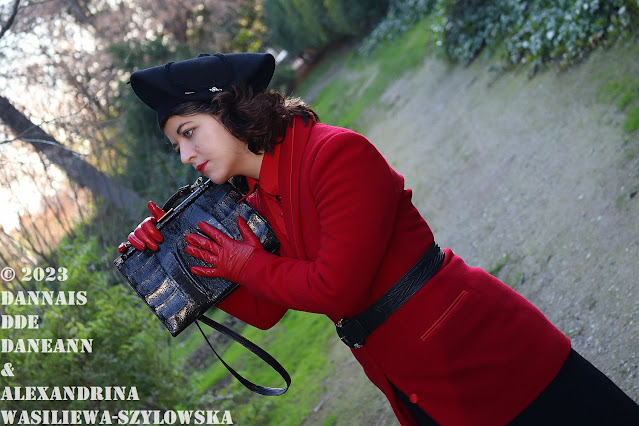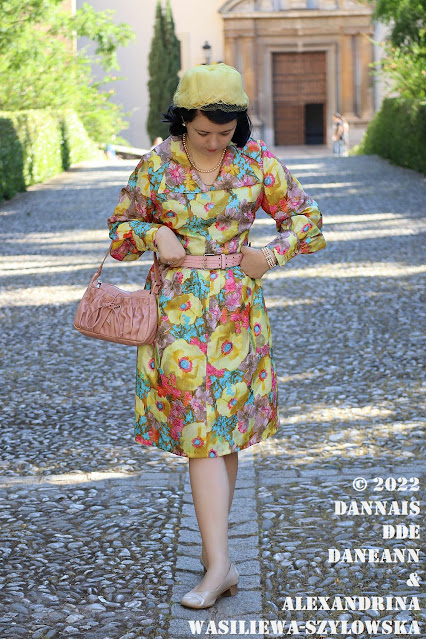Archive of 2022-2023: Cool winter outfit in style of the 1936-1937 with real vintage skirt by "Punainen Rukki"
In this outfit, I show a Finnish skirt by the Finnish boutique studio "Punainen Rukki". The name "Punainen Rukki" means "Red Spinning Wheel", which is its trademark.
It was founded in the late 1960s by textilemaker and designer Kaisa Mäkelä in Helsinki. Finding out more about Kaisa Mäkelä is not possible, because the article about this woman is in the paid online version of the newspaper. However, I managed to find out that the years of her life were 1941-2007.
Therefore, I will talk about Finnish machine knitting, which was once common in Finland, because the fabric of my skirt was machine-knitted from wool.
At the end of the 19th century, along with traditional knitting needles, a new working tool came to Finnish crafts - a knitting machine. Therefore, the knitting process has become faster. At the same time, a new profession was born - mechanized knitters working at home.
In 1889, the engineer Theodor Neovius founded a wholesale and retail shop in Helsinki selling knitting machines and yarn. From the very beginning, he actively advertised the services of his workshop and the possibility of machine weaving in several magazines.
Mr. Neovius retail shop, later "Neovius Oy", was also a regular announcer for the magazine "Naisten Ääni" from 1908.
Machine knitting and the work of machine knitters have been little studied. Researchers of crafts were not interested in this, because the work is done by a machine.
There is a lot of memorable information about mechanized knitters, for example, in village histories and family stories. Even on the Internet, you can find stories about Finnish women who in the 1910s, 1930s and 1940s used a loom to knit clothes for the inhabitants of their villages.
Machine knitting machines were no longer needed in the 1960s, when the ready-to-wear industry flooded stores with its products in abundance.
However, the Finnish atelier-boutique «Punainen Rukki» continued its own production of machine-knitted woolen fabric for sewing its exclusive custom-made clothes. In vintage online stores, such clothes cost from one hundred to several hundred euros. Which is not surprising, because "Punainen Rukki" once belonged to the Finnish High Fashion and its clothes were shown in Finnish Vogue-like magazines.
I am wearing:
I think that I got an outfit in the style of the second half of the 1930s, around 1936-1937. My vintage beret has a very shapeless look, but after I pinned it with a hat pin, it turns out to be a figured extravagant hat in the surreal spirit of Elsa Schiaparelli.
Therefore, I will talk about Finnish machine knitting, which was once common in Finland, because the fabric of my skirt was machine-knitted from wool.
At the end of the 19th century, along with traditional knitting needles, a new working tool came to Finnish crafts - a knitting machine. Therefore, the knitting process has become faster. At the same time, a new profession was born - mechanized knitters working at home.
In 1889, the engineer Theodor Neovius founded a wholesale and retail shop in Helsinki selling knitting machines and yarn. From the very beginning, he actively advertised the services of his workshop and the possibility of machine weaving in several magazines.
Among other things, "Suomen teollisuuslehti" published an advertisement as early as 1890 in which Neovius promised the buyer of the machine a course of study at the store's own school.
"One branch of domestic production to which we would like to draw attention is knitting with knitting machines. The work is healthy because these machines can be used both standing and sitting. In a short time, everyone can learn to knit almost all wool and cotton products, as well as women, men and children underwear, vests, nightgowns, trousers, socks, skirts, as well as children clothes and scarves, carpets, blankets, shawls, etc..."
Mr. Neovius retail shop, later "Neovius Oy", was also a regular announcer for the magazine "Naisten Ääni" from 1908.
In the 1930s there were only about 2500-3000 knitters in all of Finland.
Machine knitting and the work of machine knitters have been little studied. Researchers of crafts were not interested in this, because the work is done by a machine.
It also did not interest industry researchers, since the work was done at home. The knitters themselves defined themselves as representatives of home production.
There is a lot of memorable information about mechanized knitters, for example, in village histories and family stories. Even on the Internet, you can find stories about Finnish women who in the 1910s, 1930s and 1940s used a loom to knit clothes for the inhabitants of their villages.
Machine knitting machines were no longer needed in the 1960s, when the ready-to-wear industry flooded stores with its products in abundance.
However, the Finnish atelier-boutique «Punainen Rukki» continued its own production of machine-knitted woolen fabric for sewing its exclusive custom-made clothes. In vintage online stores, such clothes cost from one hundred to several hundred euros. Which is not surprising, because "Punainen Rukki" once belonged to the Finnish High Fashion and its clothes were shown in Finnish Vogue-like magazines.
My skirt dates back to the beginning of "Punainen Rukki" and is a classic example of Finnish passed away Haute Couture clothing.
"Punainen Rukki" doesn't exist anymore.
I am wearing:
- Real vintage cardinal red pure wool long fitted jacket with shawl collar by “Blue Eyes”, about 1980s
- (partly seen) Real vintage red pure merino wool long sleeve button down blouse by “Julietta”, made in Swiss, about 1960s-1970s
- Real vintage black pure wool machine knitted below knee length fourth-panel skirt with ethnic Scandinavian border by “Punainen Rukki” (Design Kaisa Mäkelä), made in Finland, about late 1960s-early 1970s
- (not seen) Black pure silk petticoat, about 2010s
- Real vintage black wool felt beret hat with matching décor, about 1930s-1940s
- Real vintage silver toned metal Treble Clef shaped hat pin with glass rhinestone, about 1930s-1940s
- Artisan hand-made black crinkled leather belt, about 1990s-2000s
- Real vintage black crocodile bag with metal clasp closure, about 1960s-1970s
- Red leather gloves, about 2010s
- Beige nylon tights, about 2010s-2020s
- Black suede high boots with mid-high heels, 2010s-2020s, made in Spain
I think that I got an outfit in the style of the second half of the 1930s, around 1936-1937. My vintage beret has a very shapeless look, but after I pinned it with a hat pin, it turns out to be a figured extravagant hat in the surreal spirit of Elsa Schiaparelli.













































Comments
Post a Comment